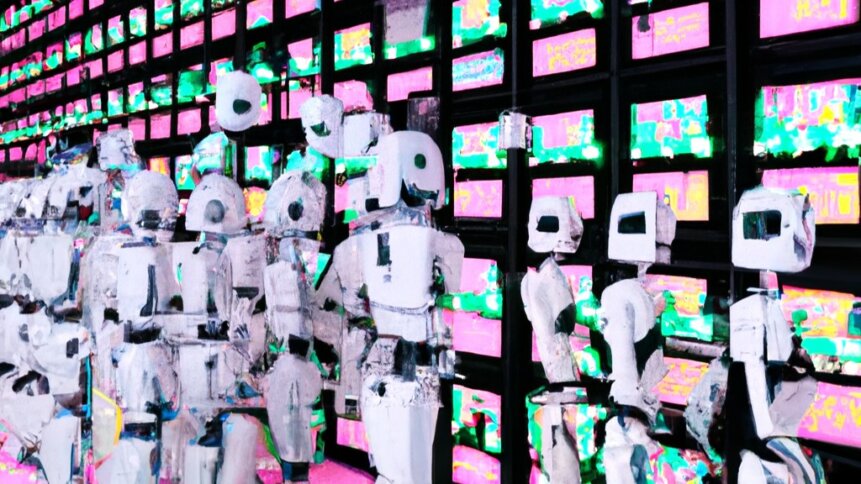How to keep your job safe in a world of AI and robots

|
Getting your Trinity Audio player ready...
|
When people see workplace AI and robots in action for the first time, two things tend to happen. Firstly, the audience is mesmerized. Tools such as generative AI, which can turn a text prompt into a photorealistic image, are mind-blowing for new users. More so, when it’s possible to edit those visuals by simply typing natural language into a box. Robots too, are captivating to watch, and have never been more affordable for firms. And that gets to the second reaction, what are the consequences for human workers? How to keep your job secure as AI and robots enter the workplace is becoming a pressing issue for more of us as the applications for AI and robots widen.
Cobots – collaborative robots – are easy to program and well-suited to repetitive tasks, which makes them a big hit on the factory floor. Priced between US $25,000 and US $35,000, and requiring nothing but a power socket and one-off programming to boost productivity, the case for robots replacing manual jobs is a strong one. What’s more, the repetitive and physically demanding nature of the tasks that come easily to cobots, such as pallet stacking, means that workers may gain more than they lose, if they can find employment elsewhere.
Given the right training opportunities, it’s certainly possible for staff to swap manual work for less back-breaking knowledge work. Robots still require some degree of supervision – even if it’s performed remotely by monitoring analytics on a dashboard. And mechanical systems need to be maintained. But, naturally, the concern is whether there’ll be enough of these new jobs to replace the ones lost to robots and AI.
The answer – for those wondering how to keep your job safe in a world of AI and robots – is that the net impact, on both job creation and skills, of firms adopting AI and robotics is positive. However, the study – which is based on a survey of over 1000 UK firms, conducted as part of The Pissarides Review into the Future of Work and Wellbeing – emphasizes that those gains only come to organizations demonstrating what’s described as high levels of readiness.
“If we want to enhance positive outcomes, management philosophy with respect to human resources really does matter, as does investment in education and infrastructure,” write the report’s authors. “The ability of firms to successfully implement new technologies depends on their access to a well-qualified, motivated, and agile workforce.”
Training cobots to do the heavy lifting.
Going back to the example of pallet-stacking cobots, there’s nobody better placed to instruct those machines on the ins and outs of getting products safely out of the door than the workers who’ve done the job manually. They’re perfectly placed to monitor and catch any issues, and are unlikely to miss having to do the task by hand – as long as they’ve got the backing of their employer and the question of how to keep your job can be put to bed.
The findings of what drives UK firms to adopt AI and robotics, and what are the consequences for jobs [PDF] are by no means isolated to a single study. In its 296-page Future of Jobs Report 2023, the World Economic Forum (WEF) writes that the impact of most technologies on jobs is expected to be a net positive over the next five years.
"AI will take your jobs" 🤡 pic.twitter.com/wL3IyQSYaA
— joan ayebola (@codesbyjoan) October 29, 2023
AI tools aren’t right all of the time, which could explain why the majority of business tasks are still performed by humans.
Considering the ‘human-machine frontier’, it was predicted in the WEF’s preceding study – conducted in 2020 – that almost half of all business tasks would be automated in the next five years. However, today organizations estimate that around two-thirds are still performed by humans – a decrease of just 1% on 2020 figures. AI and robots may be slower to take our jobs than some commentators have suggested.
Also, speaking to the need for organizations to engineer a high-level of readiness, the WEF Future of Jobs 2023 report points to ‘skills gaps’ and ‘an inability to attract talent’ as the key barriers preventing industry transformation. Having the opportunity for on-the-job training, reskilling, and upskilling is important when it comes to knowing how to keep your job secure as AI and robots enter the workplace.
What can spreadsheets tell us about how to keep your job?
Spreadsheets can be an acquired taste, with a mix of fans and critics, but they may provide a useful lesson on how the rise of AI and robotics could play out in terms of employment. Episode 606 of NPR’s Planet Money Podcast (a rerun of a show first broadcast in 2015) discusses the invention of electronic spreadsheets in the late 1970s, which quickly rendered the original paper version of the accounting tool obsolete.
In 1984, electronic spreadsheets were dubbed by some as ‘a new, possibly dangerous thing, that was about to transform the world’ (sound familiar?) – and on some counts, that description rang true. But overall, there was an upside in terms of employment.
“The spreadsheet both killed jobs, and it created jobs,” David Kestenbaum, co-host of NPR’s Planet Money Podcast, told listeners. “While the number of bookkeepers and accounting clerks fell, the electronic spreadsheet actually meant more jobs for regular accountants.”
According to employment numbers given on the show, for every bookkeeping and accounting clerk job lost since electronic spreadsheets became widely available, 1.5 accounting jobs have been added.
The big selling point for electronic spreadsheets was that they opened the door to rapid what-if analysis, which had been slow and costly when performed by penciling in and rubbing out numbers on a giant sheet of paper before the advent of PCs.
And from here, it’s not a stretch to apply those learnings to how to keep your job safe in a world of AI and robots. It’s more evidence that – as signposted in the studies referenced earlier in the article – employment opportunities could expand with the commercialization of generative AI tools and robotics.
It means that when Reuters runs headlines such as, “AI could replace 27% of jobs” [YouTube] – quoting the Organization for Economic and Co-operation and Development (OECD) – it’s worth recalling that many new roles will be created too.
Hopefully, this provides some reassurance if the topic of how to keep your job secure as AI and robots enter the workplace is weighing heavy on your shoulders.









